Biology
Biology Concepts ? apoptosis, synthaesthesia, mitochondria
It is especially difficult to avoid in biology, even scientists will say that an organism ?decides? to do this or an enzyme interacts with a substrate ?in order to? accomplish that ? the enzyme doesn?t have an agenda, it is just chemistry and physics. Assigning feelings or motives to biological entities is often a way to help explain a concept. As long as everyone agrees that it is just a technique, I think it?s fine. The problem arises when not everyone understands that its just a verbal crutch and they start to internalize it.
Then some of the skin cells between the digits began to die, and your fingers and toes started to become apparent. Sometimes the process doesn?t work completely, and people will have webs between their fingers or toes, or two digits will be fused together completely (syndactyly, syn = same and dactyl = digit). In the normal case, these skin cells are programmed to die. Why have the cell in the first place if it just going to die?
Dying well means cell death without inflammation. In apoptosis, the mechanisms work to shrink the cell away from its neighbors but keeps the cell membrane intact for most of the time it is dying. This prevents the inflammatory response from being jump started.
The extrinsic signals can cause the balance to shift toward mitochondrial leak of cytochrome c. This leads to apoptosome formation, and this activates caspases and other executioner protein enzymes that will start to destroy the cell from within. Some enzymes cut up the DNA into small pieces so that it is no longer functional. Others force the chromatin and nucleus to condense and shrink (become pyknotic) and stop making ribosomes. Some digest important proteins in the cytoplasm. The sum total of their actions is a non-functional cell, but one that is still intact. Over time, the shrunken and dying cell is recognized by macrophages or other cells that quietly break it up and digest it, all without causing any inflammation.
But this is not the only use of apoptosis in the brain. You have heard the expression, ?use it or lose it?? This applies to your brain as well. Neural connections in the brain that are stimulated by experiences or thoughts get reinforced, and are less likely to undergo programmed cell death. Those connections that are not used when young are not kept; it would be a waste of energy.
So - too little apoptosis can be a bad thing. One other big example of this is cancer. Most cells have a life span, they should die at some point. But in some types of cancer, the mutations can tip the balance in the cell and mitochondria toward the survival end; they keep living and dividing and piling up; this is a tumor.
- Prokaryotes Vs Eukaryotes
While eukaryotic cells and prokaryotic cells have some characteristics in common, they diverged from their common ancestor billions of years ago, thus accounting for significant differences in overall structure and function. Here we will go over them....
- Eukaryotic Cells
Cell Webquest ? Ms. Carter Eukaryotic Cells California Standard: Cell Biology 1.a, e, f, g CELL BIOLOGY 1 a. The fundamental life processes of plants and animals depend on a variety of chemical reactions that occur in specialized areas of the organism?s...
- #31 Control Of Cell Division, Stem Cell, Haploid And Diploid Cells
Each cell contains genes that help to control when it divides. Cells divide by mitosis only when required. When receives signals from neighbouring cells, it responds by dividing or not dividing. If this control goes wrong, cells may not divide when they...
- Necrosis
Term: necrosis Origin: Anc Greek ??????/necros(=dead) + -????/osis (=suffix meaning a state of disease) Definition:Death of cells or tissues as a result of injury or disease or loss of blood supply. Necrosis is distinguish from apoptosis which is...
- Mitochondria
Term: mitochondria plural of "mitochondrion" Origin: Ancient Greek mitos (=thread) + khondrion (=little cartilage: fibrous and flexible connective tissue ) (see below) Coined: by microbiologist Carl Benda 1898. Benda was able to make out from...
Biology
Cellular Self-Sacrifice
Biology Concepts ? apoptosis, synthaesthesia, mitochondria
We often ascribe human traits to objects that do not have thoughts or feelings of their own. This is called anthropomorphism, and it is hard to go through a day without committing this faux pas.
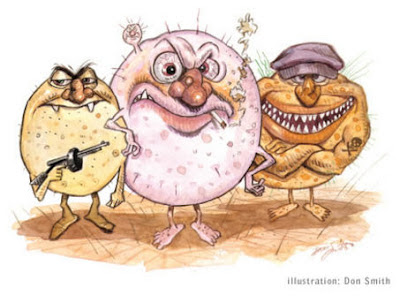 |
Anthropomorphism is difficult thing to avoid. We are thinking beings, and we look at other organisms as if we were them ? so we assign our thoughts to them. A typical example would be the belief that bacteria and viruses MEAN to do us harm, they have an evil intent when the infect us. It?s just not so??. except for athlete?s foot fungus. If you have had it before, you know that it means to make your life miserable. |
I can think of one case in particular where individual cells of a multicellular organism seem to be acting with a purpose, even a sense of altruism. It is called apoptosis or programmed cell death. In apoptosis (from Greek meaning, ?falling off?) a cell will die ?in order to? contribute to the overall health of the organism. It happens all the time. Autumn is full of apoptosis, as this is the mechanism of leaves falling, and is where the original word came from.
You just had about 1 million of your cells die as a result of apoptosis! ? There! It just happened again! About a million cells/sec ?commit suicide? (there?s some more anthropomorphism) so that you can live. If they didn?t die, you would.
It starts early, when you were in your embryonic stage. Your hands and feet started as single masses, with the bones growing in the appropriate places, at 48 days the skin covering is them all was one unit, more of a mitten than a glove.
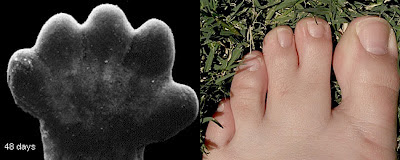 |
In utero, your hands develop with individual fingers, but covered by tissue all over, then apoptosis divides them into individual fingers. The same thing happens with your toes?. Unless it doesn?t work as it should. If it doesn?t, you end up with syndactyly, or fused digits. |
In terms of fetal formation, the cells do serve a purpose when they are formed, but that purpose is only temporary. However, this is not unlike many of your adult cells. The cells dying inside you right now probably had a ?job to do,? but now they are worn out and replacements have been made for them. In essence, most of our cells are temporary.
Apoptosis is a group of complex mechanisms that allow cells to die well. We all know about cells that do not die well. If you hit your thumb with a hammer, you kill a few thousand cells. They tear open and dump their cellular contents into the tissue around them. This signals a reaction called inflammation and perhaps a sort of immune response. Inflammation and immune responses are good at cleaning up the damage, but they can cause damage in the process. With a million cells dying every second by apoptosis, you would never survive if every death brought an inflammatory response.
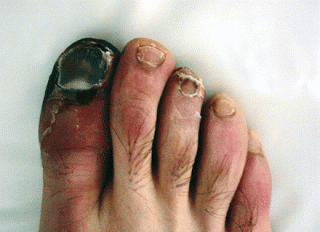 |
Necrosis is the cell death with inflammation and tissue destruction. This is what happens in frostbite. Can you imagine if you had this sort of reaction when undergoing apoptosis to make your individual fingers in utero? |
Signals from outside the cell can stimulate apoptosis, including hormones, damaging chemicals, or a loss of innervation. Sometimes it can be as little as a cell migrating from where it should be; the lack of the proper neighboring cells triggers the out of place cell to die. These are examples of extrinsic apoptosis.
But the signal could be intrinsicas well. Signals that come from inside the cell could be DNA damage, too many oxygen radicals causing damage to proteins, or even that the cell senses it has been infected by a virus. Viruses turn the cell into a virus factory, then the cell bursts to release the new viral particles and they go on to infect more cells. By initiating programmed cell death, no new viruses are made, so no additional cells will be infected and killed. As Spock would say, "They good of the many outweighs the good of the few, or the one."
The exceptional part about this process is that the mitochondrion is a crucial instigator in apoptosis. This organelle that is so crucial for life and so important for giving the cell its energy to carry out its functions, is one of the main checkpoints and instruments of programmed cell death.
If the signal for apoptosis comes from within the cell, it results in a change in the membrane of the mitochondrion, with leakage of a protein called cytochrome c out into the cytoplasm. Cytochrome c is usually held within the mitochondrion, so that the apoptosis process is held in check. Once released, this protein complexes with other proteins to form an apoptosome, and this starts a cascade toward death.
If the signal comes from outside the cell, many different receptors and pathways can be involved, but some of these will also affect the mitochondria. There are competing sets of factors in the cytoplasm, some always pushing toward cell death while others apoptosis from proceeding. The delicate balance of the factors that want to disrupt the mitochondrion and those that want to protect it allows the cell to live in harmony with itself until there is a reason to die.
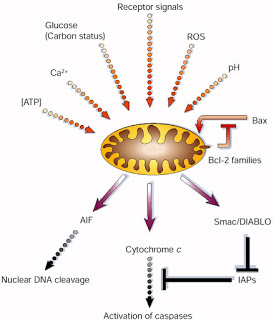 |
This cartoon is a little detailed, but the take home message is that many insults can lead to mitochondrial damage (top arrows) and the damage can lead to several signals for cell suicide ? apotposis (bottom arrows). |
Apoptosis isn?t just for your looks, as in giving you individual fingers and toes. It plays a role in every system of your body, in other animals, and even in plants. Plant cells undergo a programmed cell death, but it is a little different than animal apoptosis because they also have a cell wall to deal with and they don?t have an immune system to ingest all the dying cells. And the metamorphosis of caterpillars turning into butterflies and tadpoles becoming frogs? that couldn?t happen without a lot of apoptosis.
Your embryonic and juvenile nervous system has millions of neurons it does not need. The connections between some neurons may not be in accordance with how humans process signals, and some dying back of processes and cells is expected (called neural pruning).
Misplaced connections that do not die from apoptosis can lead to some interesting results. Synaesthesiais a group of conditions where sensory input is interpreted in more than one area. For example, if connections between taste and other parts of the brain are not pruned by apoptosis, some people will taste colors, or names will have a certain taste. Many synaesthetes (people with synaesthesia) will see number in their brains as having certain shape or texture. It is believed that most children have near photographic memories and cross innervations among the senses, but that the connections for these abilities die back in order to prevent sensory or memory overload.
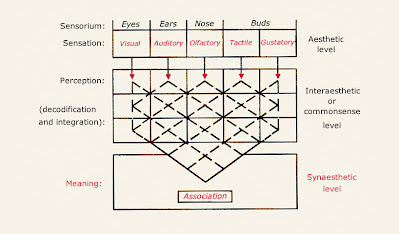 |
It is unfortunate that there aren?t very descriptive pictures that could show what it is like to have synthaesthesia ? sure you can show a colored word or set of letters, but you don?t get the idea of what it is to see it in your head when your hear a letter or word. This chart shows a little of how the senses can be combine, each combination has a name, but I like how Dr. Hugo Heyrman sums it up ? Synesthesia is a love story between the senses. |
Your immune system also relies on apoptosis. You have T lymphocytes that are designed to recognize a certain molecule that shouldn?t be in your body. Each population of T cells recognizes a different potential problem guest ? millions of them in all. But some of the T cells that are made recognize a particle that looks a lot like one of your own molecules. You don?t want that.
In your thymus and other places in your body, your T cells go through a testing process. If they recognize a protein or molecule that isn?t you, they are allowed to mature and then go out in to the body and patrol for their particular target. But if they are programmed to recognize something that is ?self? then they are signaled to undergo apoptosis.
It is a great system and works most of the time, but there are exceptions. Some ?non-self? proteins can mimic ?self? proteins, and if you start to develop an immune response to them, there may be some cross-reaction with your own cells. Or perhaps some T cells that recognize a ?self? protein don?t undergo apoptosis when they should. These issues can result in autoimmune diseases ? your immune system is attacking you.
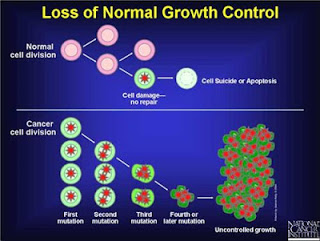 |
Cancer is a loss of cell cycle control, including the idea that cells are meant to die at an appropriate time. The problem is that there are many ways that a cell can circumvent the apoptosis signals, so you can?t induce apoptosis in all cancer cells by using just one medicine. Plus, how do you tell the cancer cells to undergo programmed cell death, but tell the normal cells to stay alive? |
Death is a part of life, and we should be thankful for it.
For the summer months I will be posting shorter stories. I will talk about questions I have about biology that could also stimulate interesting discussion. I will also look into different experiments that any individual or group can perform and which can help to open our eyes to the wonders of how biology works. In the fall, more exceptional stories should be ready to help us understand the big ideas in biology.
For more information or classroom activities on apoptosis and synthaesthesia, see:
Apoptosis ?
http://www.woodrow.org/teachers/bi/1997/apotosis/
http://www.lessoncorner.com/Science/Biology/Cell_Biology/Apoptosis
http://www.ncbi.nlm.nih.gov/pmc/articles/PMC256977/
http://www.ehow.com/how-does_5172524_steps-apoptosis.html
http://users.rcn.com/jkimball.ma.ultranet/BiologyPages/A/Apoptosis.html
http://www.youtube.com/watch?v=wREkXDiTkPs&feature=fvwrel
http://www.cellsalive.com/apop.htm
http://www.celldeath-apoptosis.org/
http://www.promega.com/resources/product-guides-and-selectors/protocols-and-applications-guide/apoptosis/
www.roche-applied-science.com/PROD.../apoptosis_003_004.pdf
http://abstracts.aspb.org/pb1997/public/P64/0400.shtml
http://www.google.com/url?sa=t&rct=j&q=&esrc=s&source=web&cd=1&ved=0CHYQFjAA&url=http%3A%2F%2Fjcmb.halic.edu.tr%2Fpdf%2F4-1%2FProgrammed.pdf&ei=9R7eT5ebCoim8gSK-pj3Cg&usg=AFQjCNEscW4eeiFGAzLuSE-mQAhR_xF3lw
www.plantsciences.ucdavis.edu/faculty/durzan/146.pdf
Synaesthesia ?
http://faculty.washington.edu/chudler/syne.html
http://web.mit.edu/synesthesia/www/
http://synesthete.org/
http://www.mixsig.net/
http://nookkin.com/content/synesthesia.php
http://www.quibblo.com/quiz/1fOzV6O/Do-You-Have-Synesthesia
http://matthewjamestaylor.com/blog/synesthesia-associating-colours-to-letters
http://www.enotes.com/documents/synesthesia-worksheet-1139
http://www.psychologyinaction.org/2011/01/28/synesthesia-when-ordinary-activities-trigger-extraordinary-sensations/
http://www.awaytoteach.net/?q=node/5128&quicktabs_2529=0&quicktabs_2530=3
https://sites.google.com/site/synesthesiaresearchteam/
- Prokaryotes Vs Eukaryotes
While eukaryotic cells and prokaryotic cells have some characteristics in common, they diverged from their common ancestor billions of years ago, thus accounting for significant differences in overall structure and function. Here we will go over them....
- Eukaryotic Cells
Cell Webquest ? Ms. Carter Eukaryotic Cells California Standard: Cell Biology 1.a, e, f, g CELL BIOLOGY 1 a. The fundamental life processes of plants and animals depend on a variety of chemical reactions that occur in specialized areas of the organism?s...
- #31 Control Of Cell Division, Stem Cell, Haploid And Diploid Cells
Each cell contains genes that help to control when it divides. Cells divide by mitosis only when required. When receives signals from neighbouring cells, it responds by dividing or not dividing. If this control goes wrong, cells may not divide when they...
- Necrosis
Term: necrosis Origin: Anc Greek ??????/necros(=dead) + -????/osis (=suffix meaning a state of disease) Definition:Death of cells or tissues as a result of injury or disease or loss of blood supply. Necrosis is distinguish from apoptosis which is...
- Mitochondria
Term: mitochondria plural of "mitochondrion" Origin: Ancient Greek mitos (=thread) + khondrion (=little cartilage: fibrous and flexible connective tissue ) (see below) Coined: by microbiologist Carl Benda 1898. Benda was able to make out from...
